Lives On The Line: The Critical Need to Preserve Funding for Domestic Violence Programs
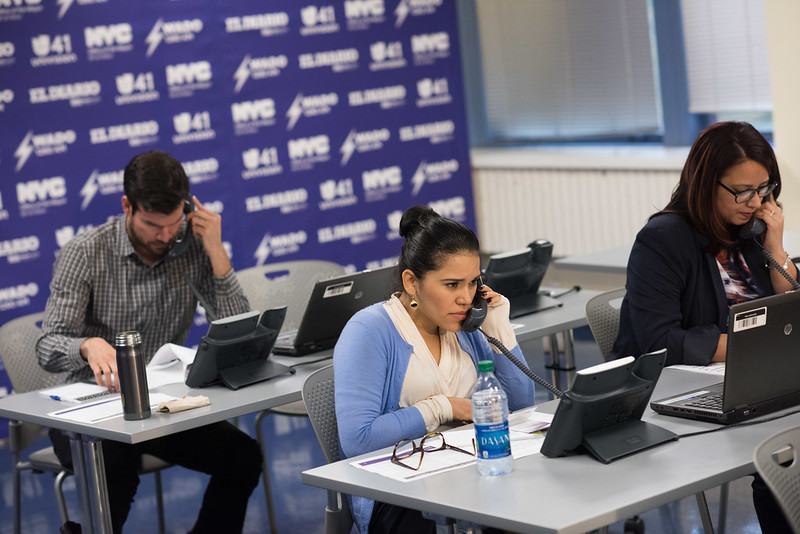
A domestic violence hotline (photo: Michael Appleton/Mayor's Office)
The COVID-19 pandemic has increased the dangers facing domestic violence survivors.
Survivors are facing escalating violence, increased isolation, and economic insecurity. And there are new and formidable barriers to finding safety. Tragically, three domestic violence victims in New York City - Vanessa Pierre, Ai Min, and Jessica Mitcham - lost their lives at the hands of abusive partners in recent days.
At this critical time, the programs domestic violence survivors depend on for essential services are more important than ever. We know that the city and state are facing profound budget challenges. As a result, the nonprofits that respond to violence and support survivors are bracing for reductions in city and state funding of the contracts that support these vital services.
I lead one of those nonprofits, Safe Horizon, the nation’s largest victim services agency. We support thousands of victims of domestic violence every year, and we are deeply concerned about what reductions in public funding would mean for our programs, our staff, and victims of domestic violence, especially when so much is at stake.
When most operations in New York City ground to a halt this spring, Safe Horizon’s domestic violence shelters remained open to ensure survivors and their families had a safe, supportive place in which to heal. Advocates at our 24-hour hotlines continued to respond around the clock to victims of violence and abuse who needed shelter, crisis intervention, or safety planning assistance. Attorneys at our Domestic Violence Law Project expertly navigated virtual court proceedings to obtain orders of protection for New Yorkers at risk of further violence.
In short, Safe Horizon and the entire network of domestic violence service providers in New York City rose to the challenge and helped keep victims and their families safe.
But right now, organizations like Safe Horizon are facing a stark future. Even as access to shelter, legal services, and safety planning is more important than ever, the public funding that supports our work is at risk.
I don’t want to mince words: Nonprofits like Safe Horizon save lives every day. Cuts to our budgets would leave countless victims of domestic violence and other crimes at risk of greater harm.
We urge our elected leaders to protect funding for organizations like Safe Horizon. We cannot afford to lose more lives to domestic violence, especially when we know that safety, security, and access to life-saving resources are possible when we invest in these programs.
***
Liz Roberts is Interim CEO of Safe Horizon, the nation’s largest victim’s services agency. Every year Safe Horizon helps 250,000 victims of violence, crime and abuse find safety, support, hope and connection. If you or someone you know is suffering from violence or abuse, call Safe Horizon’s 24/7 hotline at 1-800-621-HOPE.
***
Have an op-ed idea or submission for Gotham Gazette? Email This email address is being protected from spambots. You need JavaScript enabled to view it.
A Healthcare Worker’s Plea: No Matter Where You Live, Go Vote
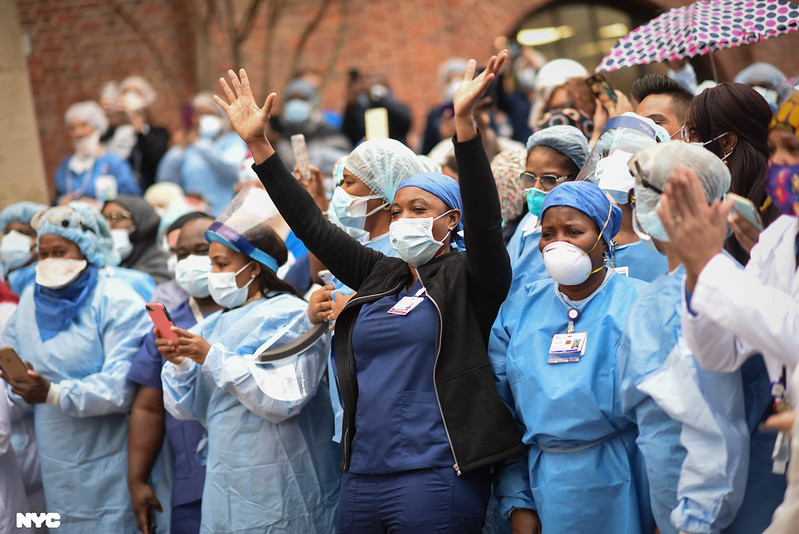
Frontline healthcare workers (photo: Michael Appleton/Mayor's Office)
Skipping family gatherings. Skipping necessary doctor’s appointments. Missing school. Missing time with friends. Losing jobs. And the deaths of loved ones. At this point, COVID-19 has affected every single American in one way or another.
As a frontline healthcare worker, I have seen firsthand the damage this pandemic has caused. While the death toll has surpassed 225,000 in the United States alone and hospitalizations begin to rise again, I have gone to work and risked my life to save the lives of others.
It did not have to be this way. And that’s why I’m urging everyone to join with me in voting for a change of leadership so we can begin to contain this devastating pandemic. No matter where you live or whether you’ve ever voted before, if you’re eligible to vote, please go out and make your voice heard for change.
President Trump and his administration – and most of us in the healthcare profession – knew in January that there was a serious virus already in the U.S. that had the potential to wreak havoc on our everyday lives. By March, we knew this was not the typical flu, but something that would spread at a much higher rate if we did not take the precautions necessary to mitigate its impact.
States began to close themselves because there was no official mandate from the federal government. President Trump repeatedly said the virus would go away quickly and easily. Meanwhile, hospital beds filled up and our access to personal protective equipment (PPE) such as masks, gloves, and gowns began to disappear, thanks to a lack of planning by the federal government that put healthcare workers at even greater risk.
In past circumstances, we have relied on science to guide us through these difficult illnesses. Contact tracing, testing, and wearing a facemask are essential. Yet, despite plenty of warning and ample time to put these measures into place, our national leadership chose to limit these proactive measures, because as President Trump phrased it in a June 15 tweet, testing “makes us look bad.” That was several months into the pandemic. After having tested positive and being hospitalized himself, the president still mocks the use of masks and downplays the virus’ risk and toll.
We need to once again allow science to guide us. President Trump has failed to protect the American people through his actions, and there are hundreds of thousands of grieving families today, and more every day, because of his administration’s inaction.
There are also millions of Americans out of work, and many families are facing childcare crises and evictions. Healthcare workers like myself are working hard every day to simply keep victims of this pandemic alive, and there is no real end in sight as we enter the winter season where things are projected to get much worse.
Healthcare workers are not the only ones who have a say in the current state of affairs—everyone should be casting their vote. Even if you live in New York or another state where you may not think the electoral votes are in play, everyone’s votes matter and are shown in tallies of the final results.
Seeing firsthand the effects of this pandemic while our president not only does nothing, but in fact makes matters worse, is as much a call to action as possible. This year, more than ever, healthcare workers must let their voices be heard and cast a vote. And so must anyone who sees the wreckage that the virus has caused, made much worse by the president’s failed leadership.
COVID-19 has ruined the lives of far too many families, and led to too much heartbreak, frustration, anger, and fear. Just like wearing a facemask, do the responsible thing, and do your civic duty. A vote on Tuesday is a vote to end this pandemic.
***
Chandra Tameshwar is a Registered Nurse who has worked in Brooklyn for five years and is a member of 1199 SEIU.
***
Have an op-ed idea or submission for Gotham Gazette? Email This email address is being protected from spambots. You need JavaScript enabled to view it.
The Power of Immigrant New Yorkers and Our Allies Must Be Felt on Election Day
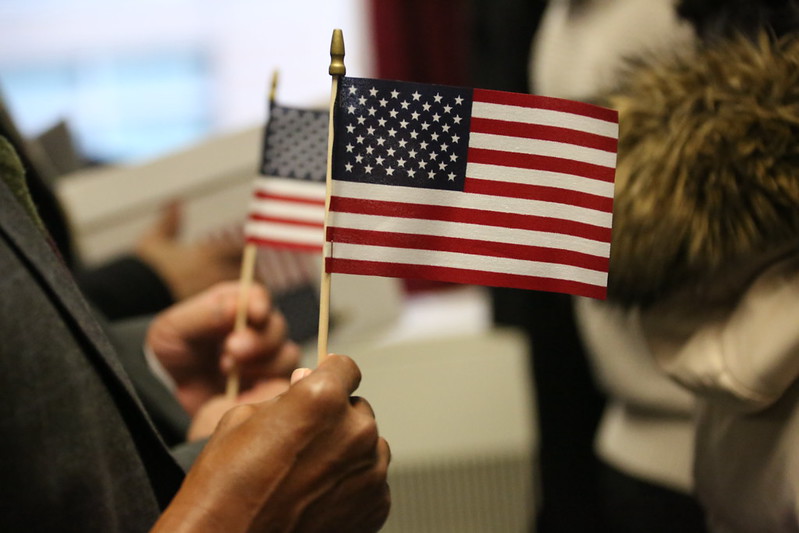
A message to spur immigrant Americans to vote (photo: Spencer T Tucker/Mayor's Office)
As a proud Guyanese-American immigrant and a leader of New York’s immigrant community, I’m getting ready to cast my vote on Tuesday, November 3. The stakes could not be higher — for myself, and New York’s 4 million immigrants.
As a Co-Executive Director of NYIC Action, the political arm of the New York Immigration Coalition, I know what’s at stake for this election. Donald Trump won in 2016 on a hateful, racist platform of walls, bans, and raids — and he’s done everything he can to transform this platform into policy. Tearing families apart, cancelling the DACA program for Dreamers, ramping up raids to terrorize New Yorkers, slashing America’s historic refugee system to pieces. This is the devastation that Donald Trump has wrought on our essential workers and immigrant communities. The choice could not be clearer: we need to vote Donald Trump out immediately.
But this election allows us to do more than that. We can make a stand for immigrant New Yorkers by getting out the vote for candidates who value the contributions of immigrants to our diverse city and against politicians who cravenly echoed Trump’s racist agenda. The time is right now to get every eligible voter you know to the polls. We need New Yorkers to vote for the kind of future that allows every single one of us to thrive.
I came to this country as an undocumented ten-year old girl from Guyana. Growing up in Brooklyn, trying to fit in, voting was one of the furthest things from my mind. But when I started to think about college, I realized, as millions of other New Yorkers have, that undocumented people face real barriers to achieving our dreams. I couldn’t apply for financial aid, couldn’t work legally, and I couldn't vote. Being disenfranchised felt like I didn't have a voice, that I was less than a full member of the community I loved, and that I couldn’t do anything to change this broken immigration system.
But I became a citizen at 20 years of age, and I can still remember that day — November 2, 2004 — when I cast my first-ever vote for President of the United States. And every time since then that I’ve cast my ballot, I’m overcome with emotion, remembering just how I felt being able to vote for a presidential nominee who presented a vision of the America I wanted to see come to fruition. So I’m determined to exercise that right every single time that I can, and now more than ever.
And when I vote on Tuesday, I know my vote is going to feel that much more important, because of what’s at stake. As a proud resident of Sunset Park, I vote for my immigrant friends and neighbors — people who yearn for a different America that welcomes them, but are undocumented or green card holders and thus can’t vote.
In 2018, NYIC Action tapped into the growing power of the immigrant vote in New York to send candidates like Andrew Gounardes, who embraced immigrant New Yorkers, to Albany. That year saw the Democrats take over the state Senate for the first time in a decade and we saw real, meaningful changes as a result, including the New York Dream Act and Driver’s Licenses for All. In 2020, we must vote to build on this victory by sending Senator Gounardes and his fellow incumbent Democrats back to the Legislature, and by powering leaders like Samra Brouk, a daughter of immigrants, into the state Senate for the first time. But our community’s voices won’t only be heard in Albany.
We will ensure that Washington hears us as well by voting for the millions of New Yorkers who are "represented" by Trump acolytes in Congress such as Lee Zeldin and Elise Stefanik, who have sadly embraced his anti-immigrant attacks and can even be defeated themselves if everyone who believes all who live in New York and the United States deserve respect from their government and are eligible show up to vote.
I vote for my loved ones, including my relatives, some of whom are still undocumented. And I vote for myself, for that ten-year-old girl who once felt voiceless, but is now ready to use my voice for my community.
But neither I nor anyone else can do this alone. We New Yorkers need to make sure that all in our community, all eligible immigrant New Yorkers, are able to vote and can cast their ballot fairly. But we also need our allies, the descendants of immigrants from across the globe and those who believe that immigrants have helped build America over centuries, to stand shoulder-to-shoulder with us. We need all who haven’t voted yet to cast our ballots together on Tuesday, November 3 — to rebuke not only Donald Trump, but the Lee Zeldins and Elise Stefaniks of the world who would attack and demean immigrant New Yorkers like me once again. We must strip them of the power to use our government against us.
On Election Day, we can do more than cast out Donald Trump, we can truly make a statement for how important immigrants are to our great state and country.
***
Rovika Rajkishun is the Interim Co-Executive Director of the New York Immigration Coalition. On Twitter @RovikaRajkishun.
***
Have an op-ed idea or submission for Gotham Gazette? Email This email address is being protected from spambots. You need JavaScript enabled to view it.
Desperate Acts of Vandalism Won’t Help Homeless People or Stop Me from Representing My Clients
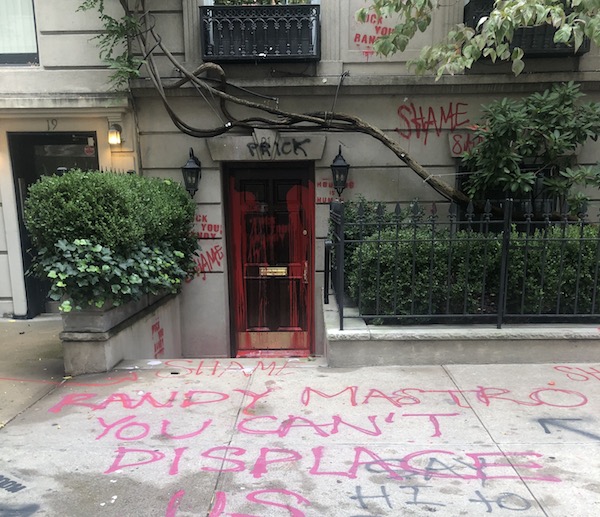
Vandalism at the home of Randy Mastro, the author
It happened two weeks ago in the dead of night. More than a dozen people wearing hoods and masks arrived on bicycles outside my family's Manhattan residence and proceeded to vandalize it.
In premeditated, coordinated fashion, the perpetrators spray-painted, in bright red and black using cut-out stencils, profanities and slogans, such as ""F**k You Randy," "Prick," "Randy Mastro You Can't Displace Us," "No Room For NIMBY's," "Shame," and "Housing Is A Human Right," on the front of our home, our neighbor's home, and the adjoining sidewalk. Not content with that obscenity, they threw eggs and buckets of red paint on our front door and put glue in the locks to make it impossible to re-enter.
Why did this happen? Apparently because of my advocacy on behalf of a client, WestCo, seeking to move homeless adults from a single-room-occupancy (SRO) hotel on the Upper West Side, the Lucerne, into a proper downtown facility, with better housing and more services, that is being converted into a permanent shelter. We thought of this resolution as a "win-win" for all concerned. Better for a neighborhood that found itself the "temporary" home to hundreds of homeless adults suddenly crammed into three nearby SRO hotels without the support services they need. And better for this vulnerable population that would be returning to a proper, full service shelter at this new downtown facility.
We had earlier petitioned Mayor de Blasio to act or else face a lawsuit. He went to visit the site himself and declared it "not acceptable." He then decided to make this move, which should have been uncontroversial but somehow caused a firestorm.
We were out of town at the time of this attack on our family's home. On the morning after, around 10 a.m., I learned of it from my next door neighbor, who emailed me that her property had been vandalized and forwarded photos of the damage.
Around the same time, one of WestCo's officers also emailed me, expressing concern for my family's safety and regret that I had been targeted in this vile way. She told me she learned about the vandalism from a website posting by an advocacy group called Open Hearts, which formed to try to keep the homeless men at the Upper West Side SRO hotel. According to Open Hearts' posts, an affiliated "minister" happened to be walking past my home in the early morning hours and witnessed the damage. Members of this group have repeatedly called me and my client "racists" and "NIMBYs."
Then came the next indignity. New York Times columnist Ginia Bellafante wrote that my advocacy as a lawyer had "ignite[d] the fury of protesters...who defaced" my family's home, as if I deserved to be victimized and brought this upon myself. She called the perpetrators of this vandalism "protesters on the other side of the debate."
But these weren't "protesters;" they're criminals who should be brought to justice. To terrorize the home of a lawyer's family because of his advocacy on behalf of clients is reprehensible. I suspect Ms. Bellafante would be far less sympathetic to "protesters" if they vandalized her home because they didn't like something she wrote. These are serious issues involving homeless people that deserve serious debate. There is no place in that debate for vandalism of a lawyer's family home or any other similar misconduct.
Sure enough, serious opinion leaders came forward to decry what had happened, which I appreciated. Unbeknownst to me at the time, the New York State Bar Association, through its President, Scott Karson, put out a public statement, "condemn[ing] the actions of all those responsible" and calling it "a despicable act of harassment for simply providing legal counsel -- a cherished principle of American jurisprudence...[A]cts of harassment, threats and intimidation against lawyers are an assault on th[e] right to counsel and must stop."
I also heard from many other leaders of the New York Bar and even local elected officials, although not the mayor, whose decision I've been publicly defending and will continue to defend. For example, Manhattan Borough President Gale Brewer, who's been an antagonist on this issue, nevertheless reached out to me personally to say she was "disgusted by the horrific act of what was written in front of your home." And my law firm colleagues and clients rallied round in extraordinary ways, for which I will always be grateful.
So maybe something good has come from this senseless act of vandalism targeting my home: A recognition that a line was crossed here that threatens not only a lawyer's family but also the very essence of our legal system -- the right to legal representation and zealous advocacy, free of "harassment, threats and intimidation." And a renewed focus on the serious issue of whether homeless adults should continue to be placed in inadequate SRO hotels or be housed in proper, safe shelters where they will get all of the services they need on-site. Of one thing, though, I am certain. If these thugs thought they were going to intimidate this lawyer, they picked the wrong guy.
***
Randy Mastro is the Chair of Citizens Union, a former New York City Deputy Mayor, and a current partner at the law firm of Gibson, Dunn & Crutcher.
***
Have an op-ed idea or submission for Gotham Gazette? Email This email address is being protected from spambots. You need JavaScript enabled to view it.
New York City Needs a Resiliency Plan that Creates Green Jobs for New Yorkers
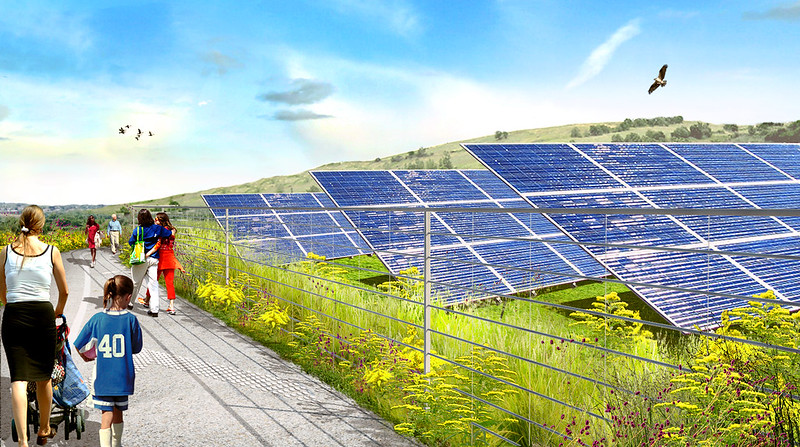
Solar panels rendering (image: Mayor's Office)
Eight years ago today, October 29, Hurricane Sandy struck the Eastern seaboard, causing severe flooding and power loss throughout New York City and the entire region. Sandy was very personal to me and my family as I know it was to many of you and yours. Friends nearby in Brooklyn lost their homes and businesses, and one even lost her life. I was honored when President Obama asked me to lead a federal task force to ensure we recovered and rebuilt stronger. The Sandy effort showed how strong and resilient New Yorkers can be. Much was learned, much was done, but unfortunately, as the storm faded from the memory of city leaders, much was left undone.
Now, New York City is grappling with yet another tragic disaster. We’ve lost nearly 25,000 of our neighbors, colleagues, friends, and family to the COVID-19 pandemic and every day we see the human and economic impact of this disaster on our great city. Sandy and the pandemic share a common theme -- the most vulnerable are disproportionately at risk when disaster strikes, so recovery must help all New Yorkers, especially the most vulnerable.
There is no doubt that Superstorm Sandy, like COVID-19, devastated the livelihoods of low-income New Yorkers. For example, in the wake of Sandy more than 80,000 New York City Public Housing Authority (NYCHA) residents were left for weeks without essential services, such as electricity, elevators, heat and hot water. After Sandy, NYCHA residents in the Rockaways, Red Hook, and other areas suffered from damaged boilers, hot water issues, and mold, as well as damage to playgrounds and other community gathering spaces, lost access to polling places, and physical isolation in their apartments.
In the name of environmental justice, we must center equity and inclusion in our rebuilding efforts – prioritizing the hardest-hit communities that are often left behind in disaster response. To help protect our fellow New Yorkers from future crises and economic downturns, we can create a pipeline of good-paying jobs that promote clean energy and resiliency. Smart policy can ensure that these jobs are accessible to residents in environmental justice communities.
The process of recovery and rebuilding since Sandy has taken too long. Eight years later, NYCHA is still undergoing Sandy-related repairs and is not prepared to deal with future climate disasters and extreme weather events. We must take necessary measures to enhance resilience, like installing flood barriers and generators and elevating utilities to higher ground. Through close collaboration with tenant associations and robust community outreach, we can ensure that tenant voices are not only heard but are a driving force behind this work.
The ingenuity of residents has the potential to transform our public housing stock, but it must be harnessed. In the process, we should also create more jobs for public housing residents, by hiring from within NYCHA and from Minority- and Women-Owned Business Enterprises. Better support for community-based organizations that help prepare and place residents into green jobs, and close coordination with NYCHA’s resident employment office, REES, will enable us to do this.
Looking beyond the public housing stock, adapting our city’s buildings to be climate-ready and pollution-free will require a workforce that is skilled and ready to take on the green jobs of tomorrow. Local, state, and federal leadership, both separately and in partnership, must do more to train New Yorkers, especially young people, people of color, and working-class communities to participate in the clean energy economy.
As mayor, I would establish a NYC Climate Corps, a citywide initiative focused on equity, inclusion, and job creation. The program would focus on equipping diverse young New Yorkers with the skills and experience they need to enter the green economy, while providing support to communities hard hit by climate change. This program would be built off the Clean Energy Service Corps, an AmeriCorps program initiated under the Obama Administration to support participants spending a year working on clean energy projects and creating green housing, via grants to nonprofits. But it would also build on local programs, such as the CUNY Service Corps and CUNY’s existing pathways to the green economy.
With an expansion and strengthening of AmeriCorps from the federal government, an investment in CUNY, and thoughtful support locally -- led by local nonprofits and hand in hand with communities -- the NYC Climate Corps could provide young New Yorkers the skills and entry-level opportunities to access careers in climate change resilience and clean energy, while supporting New York City communities. Such a program must prioritize recruiting and supporting participants from the communities they serve, and work in close coordination with labor apprenticeship programs, city agencies, and non-profit organizations supporting underserved youth college and career pathways.
I have spent my career building coalitions to solve the challenges of substandard housing, disaster response, and climate resiliency. New York City, one of the most economically unequal cities in the country, needs a mayor who is willing to work creatively across city, state, and federal lines to build a greener city and end environmental racism. Together, we can build a city that works for everyone.
***
Shaun Donovan was budget director and secretary of housing and urban development for President Obama and commissioner of housing preservation and development for Mayor Bloomberg. On Twitter @ShaunDonovanNYC.
***
Have an op-ed idea or submission for Gotham Gazette? Email This email address is being protected from spambots. You need JavaScript enabled to view it.
Shifting the Lines of Opportunity in New York City
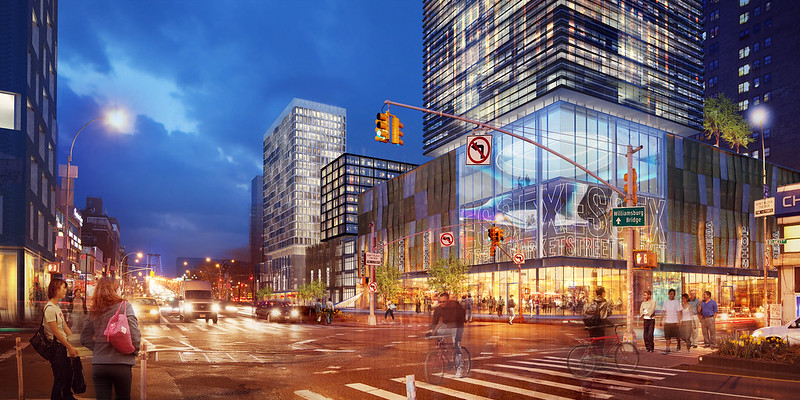
Redesign rendering (photo: mayor's office)
My family has a uniquely American story that offers inspiration -- and cause for local changes to ensure opportunity for all.
My immigrant parents of four kids were determined to achieve the American Dream but did not have access to resources or the opportunity to give their children the material needs that are often associated with being in this country.
What we did have was resolve and an unyielding faith that anyone could make it in America, if they worked hard enough.
My parents' foremost concern was their children’s need to receive a high-quality education to avoid relegating them to a cycle of generational poverty. They would often tell us, “Education is the number one anti-poverty program America has ever created, and to make it here, you have to learn."
But where we lived offered little hope. The town we resided in had one of the worst-performing school systems and was often known for violence, gangs, and children getting into drug-dealing.
My parents were unwilling to limit their children’s future, taking an extraordinary, and illegal, step to provide us with opportunity.
The neighboring town was wealthier and had high-quality public schools. When my siblings and I reached school age, my parents enrolled us in these schools by lying about their address, in violation of the law. As immigrants, my parents risked severe penalties to ensure their children would receive a good education. To them, their actions were justified because of service to their kids.
What was the outcome of their actions? We ended up excelling in school and our personal lives. My older sister became a William Fulbright Scholar and attained a Ph.D. in Psychology. My older brother became a long-haul truck driver, while teaching himself three languages and coding. My younger sister earned a master's degree in economics and has continued pursuing her studies to earn a doctorate in the field.
Our story of hope illustrates the extraordinary decisions some families have made – and will continue to make – to ensure their children are not forsaken. It is also a story that gets at the heart of structural inequities that exist in New York City today.
Our city is segregated by exclusionary zoning policies -- the drawn school and housing lines -- that ensure the wealthiest have access to valuable real estate and high-quality public education while the working class is fastened to cycles of poverty, crime, and inferior schools. These policies can be eliminated by rezoning and building more housing in areas that have historically fought against it.
Near where I live, no neighborhood better provides an opportunity for change than rezoning Soho and Noho.
By changing zoning rules in these areas we can create a minimum of 700 affordable homes in an excellent neighborhood with access to great schools. Since the COVID-19 pandemic began, over 4,200 New York City schoolchildren lost a parent due to the coronavirus. These children are not only missing an idol, but now have to deal with mental stress, loss of income, and dire consequences of what their future might look like without guidance.
With rezoning, we can prioritize housing single parents with school-age children and help rebuild their lives by providing homes in a high-opportunity area with access to high-quality schools so current and future generations of New Yorkers can unlock their full potential and lead exemplary lives.
In a recent study by Citigroup, they calculated that structural racism has cost the United States economy $16 trillion over the last 20 years, and removing these barriers that have held back generations of Americans, could increase our nation’s GDP by $5 trillion over the next five years.
But what are the true motivations behind keeping these policies in place?
Let’s be blunt: These policies exist due to greed and prejudice. Individuals who benefit from taxpayer investments, whose tax burden disproportionately falls on the lowest socioeconomic citizens of our city, have weaponized their privilege for their own prosperity.
The cornerstone of their motivation, never publicly admitted, is to ensure that property values increase to maintain their wealth. They believe that increased development would dilute the value of their property and apply the same reasoning if more people of color were to occupy “their” space.
That is the purpose of supporting exclusionary policies. It is borne out of greed and racism.
The murder of George Floyd has awoken an entire movement toward ending racist practices in policing and beyond. It is our moral prerogative to fight those – especially ones that call themselves Democrats and progressives – who are opposed to ending the racist policies that have led to generational inequities.
Our resolve and unyielding faith must be firmer than those forces that stand in opposition to creating a fairer and more just New York City. Let us rise to this call for change and offer families like mine hope.
***
Denny Salas is a candidate for City Council in Manhattan’s District 1. On Twitter @realdennysalas.
***
Have an op-ed idea or submission for Gotham Gazette? Email This email address is being protected from spambots. You need JavaScript enabled to view it.
Our Opportunity to End Solitary Confinement in New York City Jails
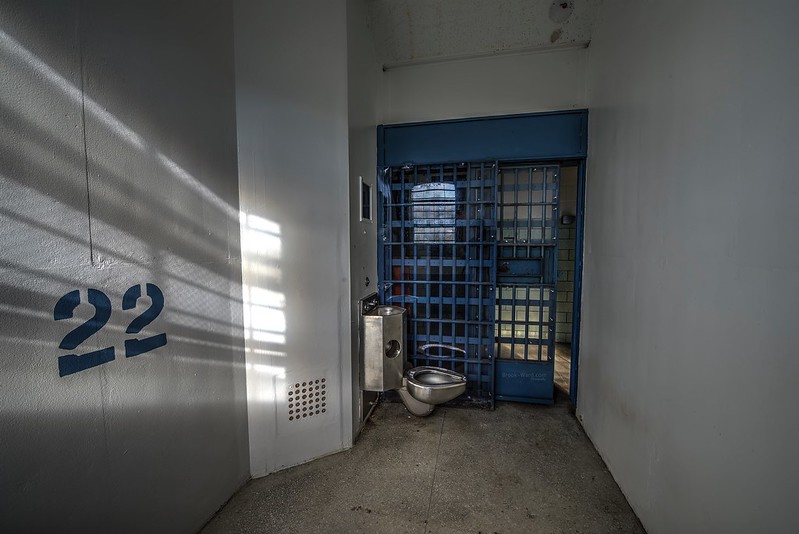
A jail cell (photo: Brook Ward)
This is a year we would all sooner forget. But 2020 can be remembered as the year New York City ended solitary confinement.
Layleen Polanco’s death in 2019 was a tragic illustration of how restricted housing and solitary confinement place people at an additional risk while being moved out of sight from urgent medical care and attention. One year later, there is an imminent opportunity to make lasting changes to the city’s criminal justice system that prevent another incident like Layleen’s from occurring.
In the days following Layleen’s death, City Council Speaker Corey Johnson and I called for an end to solitary confinement in our city jails. Even as several elected officials and advocates testified calling for its end at a Board of Correction (BOC) hearing last winter, the rulemaking process was never completed. This year, there is an opportunity to finish this work and we must seize the moment.
In June, Mayor de Blasio announced a task force to end punitive segregation, which stands as the most predominant form of solitary confinement in our city jails. In the coming weeks, the task force is due to issue its recommendations to the Board of Correction for rulemaking. With their depth of experience and expertise, Board of Correction members are well-placed to review the decisions and pass rulemaking. But they must act with urgency to change the current structure.
A 2014 study on the use of solitary confinement in New York City jails found that the majority of individuals who were subject to the practice committed self-harm: placing a person in solitary makes them over seven times more likely to harm themselves and over six times more likely to commit potentially fatal self-harm. Another report by the U.S. Department of Justice found that restrictive housing leads to serious psychological distress, as well as mistrust between staff and incarcerated individuals.
Recently, I co-authored a letter with Public Advocate Jumaane Williams that calls for a new model that focuses on reducing violence and changing behavior. Ultimately, solitary must be replaced with a model that is proven effective to reduce violence and improve outcomes. One model is the Clinical Alternative to Punitive Segregation (CAPS) program, which has been effective in reducing violence and lowering rates of self-harm through programming, therapy, and recreational activities. The Department of Correction’s (DOC) 2019 report shows that both contraband and use-of-force incidents are significantly reduced in CAPS units. CAPS units have also shown a 25% decrease in both self-injuries and injuries from fights.
Another promising model is San Francisco’s Resolve to Stop the Violence Program (RSVP), which lowered recidivism for participants by nearly 50% and reduced violent incidents per year in participating units from 24 to 1.
There are several specifics that must be considered in alternative models. As a starting point, the BOC should end the use of restraint desks in Enhanced Supervision Housing (ESH) units, in which individuals are chained to a desk. These desks are long overdue to be removed and should be eliminated in this process. Second, the DOC should allow legal or advocate representation to be present at disciplinary hearings. Finally, we have to set a higher standard for what qualifies as adequate out of cell time than the state’s standard. I have called for a standard of 14 hours of out of cell time with enhanced services to address violence, but any rulemaking must set a higher standard than the four-hour minimum enshrined in state law.
The next few weeks will be critical for this issue. With action, we can enter a new era of justice and mark 2020 as the year that we ended solitary confinement in New York City.
[Read: Plan for Ending Solitary Confinement in City Jails is Imminent, Board of Correction Chair Says]
***
City Council Member Keith Powers represents parts of Manhattan and chairs of the Council’s Criminal Justice Committee. On Twitter @KeithPowersNYC.
***
Have an op-ed idea or submission for Gotham Gazette? Email This email address is being protected from spambots. You need JavaScript enabled to view it.
Closing Rikers Must Remain A Priority, and We Can Do It Without Building New Jails
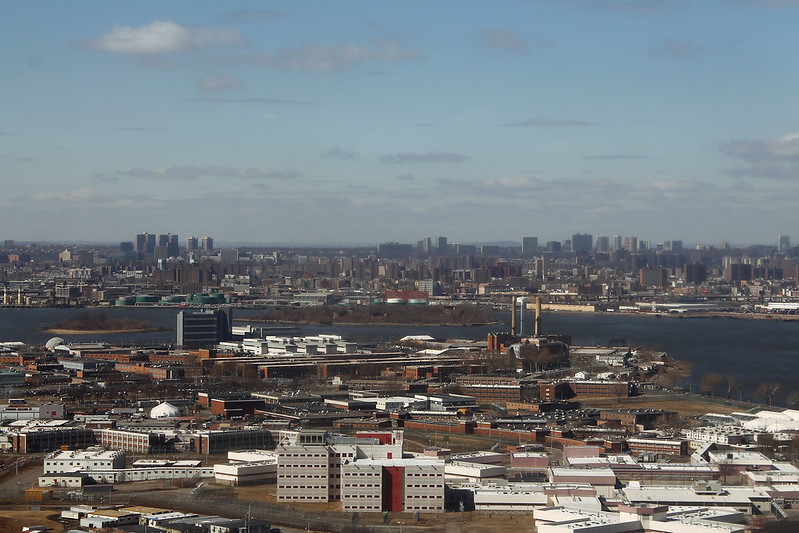
Rikers Island (photo: formulanone)
New York City’s historic commitment to closing the Rikers Island jail complex is in jeopardy. Thanks to an adverse court ruling, a struggling budget, and unfocused political leadership, Mayor de Blasio’s plan to build four new jails at a cost of $9 billion is endangered -- and so is the very idea of closing Rikers. In recent weeks, the discussion over Rikers closure has devolved into debates about real estate, and lost sight of the people and communities harmed by our medieval jail complex and broken criminal justice system.
It’s time to focus on how to close Rikers quickly and responsibly -- and without building new jails.
When I helped launch the campaign to close Rikers Island in 2016, most people in politics were deeply skeptical, if not outright opposed. But along the way, we built a 180-organization coalition, won over nearly every elected official in New York City, forced a commitment to closure from Mayor de Blasio, and watched the City Council dramatically pass legislation with a timeline for closure.
Our goal on the #CLOSERikers campaign had been threefold:
Shutter the Rikers Island jail complex, an 85-year moral stain on our city.
Dramatically reduce the number of New Yorkers in jail pre-trial, particularly people there simply because they are too poor to pay bail.
Invest in and build up communities most harmed by mass incarceration, so that fewer people get ensnared in the system in the first place.
Lost in the myriad controversies over the Rikers closure plan have been the significant successes over the past few years. For all the controversy over last year’s City Council vote, it ultimately put about 80% of the Council on the record supporting closure. This year New York City’s jail population reached its lowest point in decades, fewer than 4,000 people. (There are currently about 4,600 due to a recent uptick.)
In 2019, the New York State Legislature passed major reforms to bail (wrongly partially rolled back in 2020), discovery, and speedy trial laws. Investments in community-based “violence interruption” programs are up. Restorative justice programs are taking root in Brooklyn and the Bronx. Each subsequent election for District Attorney -- Brooklyn in 2017, Queens in 2019, Manhattan in 2021 -- has featured more progressive ideas around what criminal justice reform should look like.
All of which brings us to the real question we should be asking right now: how can we close Rikers without building new jails? There was an aborted version of this debate before the 2019 City Council vote. While I argued then that Rikers should be closed without building new jails, those of us who supported that view didn’t do enough to explain how that would work, and Council members were largely uninterested in listening. Now, with the entire plan in jeopardy, it is imperative that we have that conversation.
First, we must remind people that we already went through an exhaustive citywide debate about why Rikers Island must close. It is beyond reform, a brutish penal colony that has bucked attempts to “improve conditions” every generation since its founding. Second, we must point out that nearly everyone on Rikers Island is there either pre-trial (legally innocent), for a technical parole violation (things that would not be a crime for regular people), or serving a short jail sentence for a misdemeanor (often petty crimes). Having established that Rikers is a horrible place, and most people currently jailed there are not the dangerous villains stereotyped by some on the right, what are steps we can take to further reduce the jail population, so that we don’t need to build new jails?
Continue passing legislation to reform the justice system. We’re sending more progressive State Senators and Assembly members to Albany than any time in recent history. Pre-covid, “technical parole violations” were the fastest rising cause of people being jailed at Rikers, and typically represent around 10% of people in our jail system. Let’s fix our long-broken parole system, so that people coming home from prison can actually get back on their feet instead of cycling through our jails over and over again. This will reduce our average jail population by about 700 people.
Build a real community-based mental health-care program. This is something we all need as New Yorkers, as covid has made abundantly clear. A robust mental health-care system will require significant work to build, but as anyone who has struggled with or seen a loved one struggle with mental health can attest, it will be more than worth it. At Rikers Island, up to 40% of detainees experience mental health issues, and an increasing share have serious mental illness, about 1,100 (or 16%) according to 2019 figures. Finding community-based support for any substantial group of people who would be better served there instead of jail would reduce New York’s jail population by hundreds as well.
Invest in programs that break the cycle of harm. We already have great programs that work with young people who get in trouble with the criminal legal system, let’s put more resources into them to help more young people get their lives back on track. Right now about 500 people in our jails are 18-21, and many more are in their early twenties. We shouldn’t give up on them. If you’re wondering how to pay for this, consider that we spend approximately $300,000 per person per year to incarcerate someone on Rikers. The money’s there, we’re just spending it on cages.
These are just a handful of ideas to reduce the number of people in jail, while improving public safety. The same City Council members who gave long-winded speeches about their historic vote to close Rikers a year ago should be holding hearings now on how to get this done. Mayor de Blasio should show some humility and re-evaluate his unpopular new jails plan. Community groups fighting so hard to block jail construction should demonstrate their sincerity to closing Rikers by lending their support to reforms in this moment. And as a Manhattan District Attorney candidate, I pledge to cut our jail population by 80% so that we don’t need a new jail in Manhattan.
Closing Rikers Island without building any new jail beds would require cutting our jail population to about 2,300, the existing capacity of the Tombs, Brooklyn House of Detention, and VCBC, the barge in the Bronx. These are all deplorable facilities, and while living conditions there can be improved marginally, in 2021 we must have a robust conversation about what system replaces Rikers Island in the long-term, but it should not be de Blasio’s planned jail towers.
Closing Rikers is a big deal. We can be the city that shows America the path out of the dark days of mass incarceration, and provide a different model for justice. Let’s make history together.
***
Janos Marton was a leader of the #CLOSErikers movement and is a candidate for Manhattan District Attorney. On Twitter @janosmarton.
***
Have an op-ed idea or submission for Gotham Gazette? Email This email address is being protected from spambots. You need JavaScript enabled to view it.
Why the Science Around COVID-19 Keeps Changing So Much and a Vaccine Can’t Be Rushed
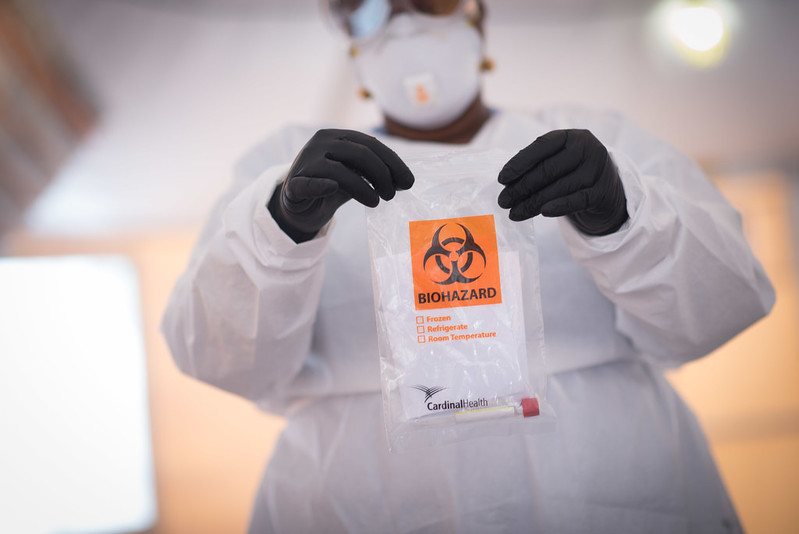
Covid testing in New York (photo: Michael Appleton/Mayor's Office)
We are now more than halfway through October, it’s been seven months since New York State went on PAUSE and President Trump continues to tout unrealistic ideals of the speed scientists will be able to create a vaccine for COVID-19. In the first presidential debate and since, Trump continues to show a true misunderstanding of scientific research. In order to make good choices to avoid more covid spikes and prolonged suffering, allow students to return to school safely, and more fully resume life before coronavirus, we must understand the speed and process of scientific research -- and let it take its course responsibly.
We have learned a lot in seven months. On March 22, we knew relatively little about how the disease was being transmitted, what we could use to treat it, and what the long-term impacts of the disease were. And yet, politicians had to make choices to protect their constituents, cities, and states. We will need to put what we have learned to the test to avoid a second wave in New York and more infection spikes across the country, and we must allow the scientific process to unfold.
The early response to COVID-19 in New York, unaided by the federal government, has widely been considered a mess. This disaster highlights the complications of making what should be science-based policy before the scientific research is performed or vetted. This pandemic draws attention to the need for transparency, communication of changing information, and public understanding of the speed and nature of scientific research.
Scientific research is built for discovery over time, not rapid speed. The key to understanding why the early guidance on COVID-19 changed repeatedly lies in understanding the method of scientific research and peer review. This applies to figuring out how COVID-19 spreads, the importance of mask-wearing, and the development of a vaccine, among other key pieces of the larger puzzle of a new, deadly virus.
In reality, a published scientific study that can accurately provide findings typically starts many years before it is disseminated. Publication is the end goal for scientists to share the results of their carefully-performed and -vetted research, including rigorous peer-review commentary. Proper design helps to plan out experiments that will reach the estimated goal in a timely manner. Studies must be funded. Biological studies can take many months to years to complete the necessary experiments and statistical analyses.
In the case of COVID-19, many important logistical steps, like funding, may be fast-tracked, but even with widespread desperation for a vaccine, scientific research cannot and must not be rushed. As vaccines proceed through development stages, other research works in parallel understand the complex new virus.
One or more COVID-19 vaccines will eventually go through the federal Food and Drug Administration process. The scientific research involved will also be published in scientific journals at various points including, exploratory research, preclinical models, and clinical trials. Again, this highlights the importance of greater general public understanding of the underpinnings of how so much of the research into COVID-19 and other science typically happens.
Scientific manuscripts -- usually defined as full research articles with novel findings -- must include background, motivation, methods, results, and discussion of how the work fits into the broader scope of the relevant literature. When completed, the manuscript is submitted to a journal where it goes through the process of peer review, described by Elsevier as existing to “validate academic work” and “improve the quality of published research.” Other scientists review the paper in a process that can take from a few weeks to several months, providing feedback on process and conclusions. Based on the peer review, the paper can be rejected or accepted by the journal.
If accepted with revisions, the scientists complete additional experiments, analyses, and writing before resubmission and more review. The article is finally published -- signifying necessary academic quality -- after the final round of revisions is complete. This is usually at least a year after the initial experiments were performed.
During the pandemic, scientists have been working around the clock at speeds not normally observed in biomedical research to attempt faster discoveries of many things including the genetic make-up of the virus, how the virus is transmitted, treatments, and vaccines.
Scientists didn’t initially recommend against masks because they didn’t want to control the virus, or because masks don’t help. Scientists didn’t recommend wearing masks due to some combination of not understanding the mechanism of COVID-19 spread, wanting to avoid N95 mask supply issues, and assumptions of low disease presence. Studies have now found that the virus can be transmitted before symptoms or while asymptomatic, and some studies like one from Alvin Ing show as many as 80% of cases could be asymptomatic. We know more about the virus now, and that helps scientists and policy-makers to make educated choices about masks.
In the last six months, because of scientists, we have learned how vital masks are to decreasing transmission. We have also learned that hydroxychloroquine provides no benefit to COVID-19 patients. Scientists have also developed new testing methods for COVID-19, including a saliva test recently approved by the New York State Department of Health.
When things are moving at pandemic speed, we need to search out the knowledgeable scientific voices that we know guide the public in the right direction, but more importantly we need transparency on changing science. Transparency and communication are key to combating public health crises. COVID-19 will not have a miracle cure. It will have a cure that is developed and tested by hard-working scientists working faster than ever imagined.
Guidelines changing are not a sign of misinformation and false ideas, but rather a symptom of evolving scientific understanding of the virus. It will be a long time, certainly years, before we truly understand the complexities of this novel coronavirus. To avoid another wave while we wait for tireless scientists to develop a safe vaccine, we must listen carefully to those who are on the frontline learning more about the virus every day.
***
Samantha L. Marshall, PhD, is a postdoctoral research scientist in Orthopedic Surgery at Columbia University Medical Center in New York, NY and a volunteer with Sci4NY.
***
Have an op-ed idea or submission for Gotham Gazette? Email This email address is being protected from spambots. You need JavaScript enabled to view it.
I Am A Black Lobbyist; My Profession Must Change
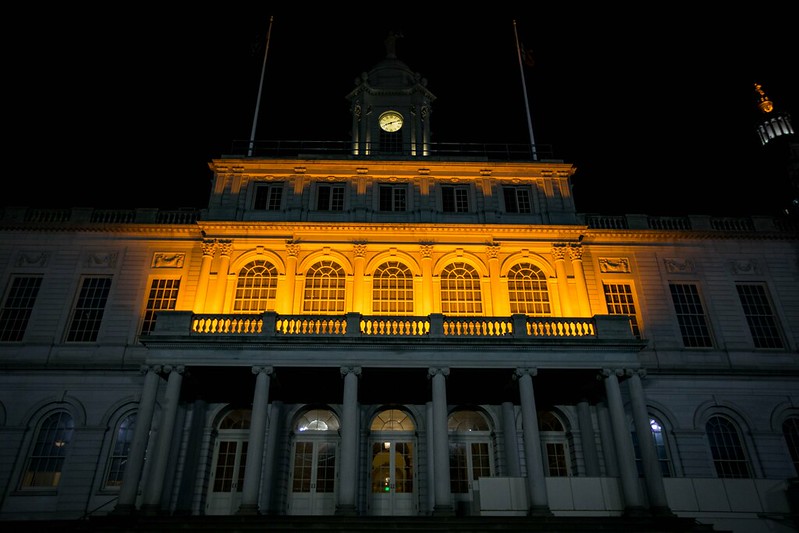
New York City Hall (photo: Benjamin Kanter/Mayoral Photo Office)
The Friday after George Floyd was murdered, I sat in my Harlem apartment seething. For the first time since 2012 I could not join the protests. The lobbying firm I worked for asked me to review a City Council hearing and take notes for a client. No capacity to pay attention, I just took the notes.
Civil rights organizations spoke, law enforcement agencies followed, one legislator after another yelled louder than the previous about racism, the prison industrial complex, and companies making ungodly amounts of money from this system. One of these groups was a client that we worked with on different issues. But, as the hearing was nearing the end, the company I was taking notes for was called out by name for charging exorbitant fees and fines to families with incarcerated loved ones. It stopped me in my tracks. My confusion turned into a blinding rage.
As a Black man in America, I long ago learned the ugly history of our prison system. I know vagrancy laws criminalized former slaves unwilling to work on plantations. I know Black people were jailed for perceived disrespect of white folks. We went to jail for voting. And whenever a person goes to jail every part of the process from arrest to probation becomes a money grab by the state and corporations.
I know this because at that exact moment one of my siblings sat in a jail cell. During a mental health crisis in the winter of 2019, they ended up in jail after an altercation. They refused to speak to my family or their lawyer. What should have been an evening in jail turned into a few days, then a few weeks, then a few months. A judge ordered a mandatory psych evaluation and deemed my sibling unfit to stand trial. The system crawled to take care of their housing and mental health needs while my sibling was in jail. At the time I was taking notes for this client, they had been in jail for five months and my family was dealing with the prices that companies charge for simple phone calls.
I could not cope with the distance between my experiences as a Black person in this country and the amoral position I was expected to take as a lobbyist. I felt the crushing weight of every Black person who has faced a similar dilemma struggling between financially supporting our loved ones and shackling ourselves to our own oppression. My mental health started to decline under the trauma and stress. I began to have nightmares. I took off work to clear my head.
Growing up my family almost never discussed politics. In fact, they hated it. No one in my family believed the political system benefits people at the bottom of the well like us. Inspired by President Obama's grassroots campaign, I started my career in politics heeding the call to fight cynicism and apathy, and rise up to bend the moral arc of the universe in the direction of justice. My work with that client was the opposite of justice and I knew it. The fog cleared and my path was obvious.
I returned and told my boss I couldn’t work for this client. I heard the usual excuses that this client does more than just services for prisons. I was told that we represent clients who also advocate for ending the racist criminal justice system. Sometimes we help corporations do things we may object to so we can advocate for nonprofits who couldn’t afford us otherwise. To paraphrase, we do a little bad to do some good.
This is indicative of why lobbyists are America’s most reviled professionals. A Gallup poll found 71% of Americans believe that lobbyists have too much power and only 7% believe lobbyists are highly ethical or honest.
We deserve our reputation. A lobbyist will represent a nonprofit advocating for affordable housing in the morning and a luxury developer opposing affordable housing in the afternoon. But, lobbying is a first amendment right and must be part of the solution to the democratic crisis our nation is facing.
Lobbyists actually have an important role to play as guardians of our democracy: the business world needs their expertise, nonprofits work with them to secure funding and policy changes, and they should serve as connectors between legislators and constituency groups. Every lobbyist has a responsibility to hold themself to a strong standard of justice.
Please understand, I worked with good people who want to do the right thing but they are hemmed in by an industry culture that largely requires detachment, amorality, and indifference to the greater good.
It wasn’t always so, America’s first known lobbyist was a Revolutionary War patriot hired by fellow veterans to demand the federal government pay our soldiers the compensation they were owed. In the Progressive Era, the political class advocated to improve working conditions and labor practices. Lobbyists expanded educational opportunities, sought humane living conditions for the poor, and fought for civil rights.
As our nation confronts a global pandemic, faces a reckoning with deeply embedded racism, and fights catastrophic wildfires and hurricanes brought on by climate change, it’s time for lobbyists to return to those roots.
Black Lives Matter activists protest every day demanding we reimagine public safety. Newly-elected young progressives struggle to pass laws to make government work for ordinary Americans. Nonprofits and schools are squeezed at every turn. Where are the lobbyists? Mostly, they are making sure we don’t tax billionaires while shoring up corporate profits.
Lobbyists are vital cogs in the political ecosystem, they are highly sought after and well-compensated for their expertise. Lobbyists are former elected officials, labor leaders, and government staffers who know more than almost anyone how our political institutions function. They are uniquely situated to research and diagnose problems, create solutions, and pressure elected officials, the business community, and the public to implement change.
Lobbyists can easily be part of progressive change. They must reorient themselves by doing three things:
Advise clients towards justice. Before accepting a contract, a lobbyist must first ask, what is the goal and is this in the public’s interest? Then counsel the client in creative ways to get there. For example, gig employers who can’t afford to take on employees but want workers to have sick days, health care, and retirement might find a solution in pooled benefits.
Ban clients from giving money to politicians. Hiring a lobbyist is always an attempt to influence government. If the clients of lobbyists are giving money to those making the rules, you will not be able to convince the public that such transactions are not corruption. Perception is reality.
Be an organizer. Lobbyists have a responsibility to organize constituencies--corporations, nonprofits and citizens--to solve big problems. Lobbyists need to leverage their collective knowledge and expertise, their trusted relationships with elected officials, and their clout in the business community to help shape our democracy into one that secures life, liberty, justice, and prosperity for all.
If “government is simply the name we give to the things we choose to do together,” as former U.S. Rep. Barney Frank of Massachusetts once said, then lobbyists must instill values of justice into every aspect of their work. By dedicating themselves to work for the public good lobbyists can save democracy and restore the American dream.
***
Paul Hypolite is the founder of Leading with Our Values, a government relations and public affairs firm committed to economic, racial, gender, and environmental justice.
***
Have an op-ed idea or submission for Gotham Gazette? Email This email address is being protected from spambots. You need JavaScript enabled to view it.
Letter to the Editor: How Citi is Part of the New York Recovery
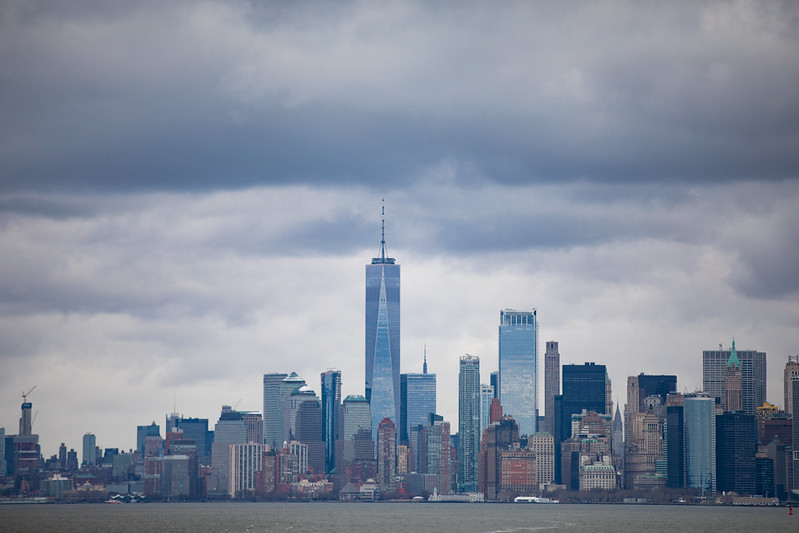
New York City (photo: Benjamin Kanter/Mayor's Office)
To the Editor,
A recent opinion piece – “Time for the Big Banks to Reinvest in New York City” – mischaracterized Citi’s approach to its workforce in the city and its commitment to providing relief during the pandemic. We haven’t relocated any employees to the suburbs and we haven’t prioritized federal PPP loans to wealthy corporations at the expense of New York City’s vital small businesses community.
When the pandemic hit, Citi was one of the first to step up to help the city through one of its greatest crises in history. We have distributed PPP funding to nearly 9,000 of the hardest-hit small businesses in the five boroughs – many of them employing three or fewer people. Through the Citi Foundation, we are donating $25 million in profits from our participation in the PPP program to community lenders and our partners at the state level who will help even more small businesses reopen and communities of color get the support they need. We’ve also repurposed the cafeteria at our headquarters to prepare more than 40,000 free meals for struggling families and we helped provide free annual Citi Bike memberships to more than 26,000 critical workers.
The fact is, we believe in New York City – we always have and always will. This is our home. Citi has made vital contributions to the economic and social life of the city since we were founded here more than 200 years ago. You can see that in the bank branches and affordable, high-quality products that support the financial lives of people in every neighborhood. You can see it in the $587 million in affordable housing we’ve financed since 2019 and in the thousands of employees who volunteer to coach and mentor young New Yorkers.
And make no mistake: we will play a central role in New York’s recovery. We are one of the city’s largest private sector employers and, while we’ve kept many branches open and continue to serve our customers seamlessly, we are determined to get everyone back to our headquarters in Lower Manhattan as soon as it is safe to do so. We will continue to invest in affordable housing, in expanding financial access in underserved neighborhoods and in other initiatives to make New York more livable, more inclusive and more prosperous. This is a core goal of our business – because we believe that a stronger city makes for a stronger Citi.
Sincerely,
Brandee McHale
Head of Citi’s Community Investing & Development
***
Have an op-ed idea or submission for Gotham Gazette? Email This email address is being protected from spambots. You need JavaScript enabled to view it.




